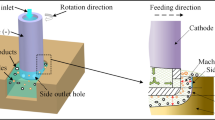Abstract
Die-sinking electrical discharge machining is an unconventional technology that allows to machine all at least minimally electrically conductive materials regardless of their physical and mechanical properties. Despite the fact that it is not a conventional technology, the tool gets also worn out, which is a tool electrode. The wear of the electrode does not only mean its loss but also the degradation of the shapes that are transferred to the resulting workpiece. For this reason, a design of experiments was conducted with 6 input factors, 2 were categorical: the electrode material (copper, graphite) and workpiece material (steel 1.2363 and steel 1.2343ESR) and 4 were numerical: Open-voltage, Pulse current, Pulse on-time, and Pulse off-time. In the framework of this design of experiments, the wear of the used graphite and copper electrodes at their corners and edges was evaluated, which was made possible by the use of electron microscopy and the use of approximation circles. Furthermore, the eroding speed, the topography of the machined samples, and the morphology of the surfaces of the used electrodes were investigated. It has been recognized that the use of a graphite electrode will allow for more accurate workpiece shapes and less wear.








Similar content being viewed by others
References
Meshram DB, Puri YM. Review of research work in die sinking EDM for machining curved hole. J Braz Soc Mech Sci Eng. 2017;39(7):2593–605.
Khan D, Goswami H, Somkuwar V. Process parameter optimization of die sinking EDM: a review. Int Res J Eng Technol. 2018;5:1493–500.
Singh NK, Pandey PM, Singh KK, Sharma MK. Steps towards green manufacturing through EDM process: a review. Cogent Eng. 2016;3(1):1272662.
Selvarajan L, Rajavel J, Prabakaran V, Sivakumar B, Jeeva G. A review paper on EDM parameter of composite material and industrial demand material machining. Mater Today Proc. 2018;5(2):5506–13.
Bleys P, Kruth JP, Lauwers B, Zryd A, Delpretti R, Tricarico C. Real-time tool wear compensation in milling EDM. CIRP Ann. 2002;51(1):157–60.
Luis CJ, Puertas I, Villa AG. Material removal rate and electrode wear study on the EDM of silicon carbide. J Mater Process Technol. 2005;164:889–96.
Tsai YY, Masuzawa T. An index to evaluate the wear resistance of the electrode in micro-EDM. J Mater Process Technol. 2004;149(1–3):304–9.
Khan AA. Electrode wear and material removal rate during EDM of aluminum and mild steel using copper and brass electrodes. Int J Adv Manuf Technol. 2008;39(5–6):482–7.
Narasimhan J, Yu Z, Rajurkar KP. Tool wear compensation and path generation in micro and macro EDM. J Manuf Process. 2005;7(1):75–82.
Klocke F, Schwade M, Klink A, Veselovac D. Analysis of material removal rate and electrode wear in sinking EDM roughing strategies using different graphite grades. Procedia CIRP. 2013;6:163–7.
Yin Q, Wang B, Zhang Y, Ji F, Liu G. Research of lower tool electrode wear in simultaneous EDM and ECM. J Mater Process Technol. 2014;214(8):1759–68.
Torres A, Luis CJ, Puertas I. Analysis of the influence of EDM parameters on surface finish, material removal rate, and electrode wear of an INCONEL 600 alloy. Int J Adv Manuf Technol. 2015;80(1–4):123–40.
Maradia U, Boccadoro M, Stirnimann J, Kuster F, Wegener K. Electrode wear protection mechanism in meso–micro-EDM. J Mater Process Technol. 2015;223:22–33.
Kumar NM, Kumaran SS, Kumaraswamidhas LA. An investigation of mechanical properties and material removal rate, tool wear rate in EDM machining process of AL2618 alloy reinforced with Si3N4, AlN and ZrB2 composites. J Alloy Compd. 2015;650:318–27.
Mouralova K, Prokes T, Benes L, Bednar J. The influence of WEDM parameters setup on the occurrence of defects when machining Hardox 400 Steel. Materials. 2019;12(22):3758.
Mouralova K, Prokes T, Benes L, Sliwkova P. Analysis of sub-surface defects occurrence in abrasion resistant Creusabro steel after WEDM including the study of morphology and surface topography. Mach Sci Technol. 2019;24:1–17.
Mouralova K, Klakurkova L, Matousek R, Prokes T, Hrdy R, Kana V. Influence of the cut direction through the semi-finished product on the occurrence of cracks for X210Cr12 steel using WEDM. Arch Civ Mech Eng. 2018;18(4):1318–31.
Mouralova K, Benes L, Prokes T, Bednar J, Zahradnicek R, Jankovych R, Vontor J. Analysis of the machinability of copper alloy ampcoloy by WEDM. Materials. 2020;13(4):893.
Geometrical Product Specifications (GPS) -Surface texture: Areal -Part 2: Terms, definitions and surface texture parameters. ISO 25178–2 (2012). Geneva: International Organization for Standardization.
Geometrical Product Specifications (GPS) -Surface texture: Profile method -Terms, definitions and surface texture parameters. ISO 4287 (1997). Geneva: International Organization for Standardization.
Kiyak M, Çakır O. Examination of machining parameters on surface roughness in EDM of tool steel. J Mater Process Technol. 2007;191(1–3):141–4.
Amorim FL, Weingaertner WL. The behavior of graphite and copper electrodes on the finish die-sinking electrical discharge machining (EDM) of AISI P20 tool steel. J Braz Soc Mech Sci Eng. 2007;29(4):366–71.
Bleys P, Kruth JP, Lauwers B, Schacht B, Balasubramanian V, Froyen L, Van Humbeeck J. Surface and sub-surface quality of steel after EDM. Adv Eng Mater. 2006;8(1–2):15–25.
Zarepour H, Tehrani AF, Karimi D, Amini S. Statistical analysis on electrode wear in EDM of tool steel DIN 12714 used in forging dies. J Mater Process Technol. 2007;187:711–4.
Ho KH, Newman ST. State of the art electrical discharge machining (EDM). Int J Mach Tools Manuf. 2003;43(13):1287–300.
Funding
This work was supported by the Technology Agency of the Czech Republic, project no. TJ02000311. CzechNanoLab project LM2018110 funded by MEYS CR is gratefully acknowledged for the financial support of the measurements/sample fabrication at CEITEC Nano Research Infrastructure. This work was supported by the Brno University of Technology Specific Research Program, project no. FSI-S-17-4464.
Author information
Authors and Affiliations
Corresponding author
Ethics declarations
Conflict of interest
Authors K. Mouralova, J. Bednar, L. Benes, P. Hrabec, M. Kalivoda, and J. Fries declare that they have no conflict of interest.
Additional information
Publisher's Note
Springer Nature remains neutral with regard to jurisdictional claims in published maps and institutional affiliations.
Rights and permissions
About this article
Cite this article
Mouralova, K., Bednar, J., Benes, L. et al. The analysis of EDM electrodes wear in corners and edges. Archiv.Civ.Mech.Eng 20, 130 (2020). https://doi.org/10.1007/s43452-020-00137-8
Received:
Revised:
Accepted:
Published:
DOI: https://doi.org/10.1007/s43452-020-00137-8




